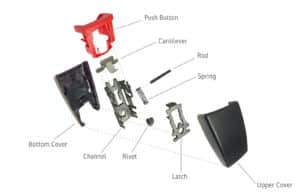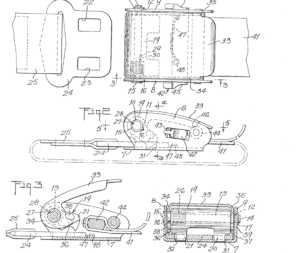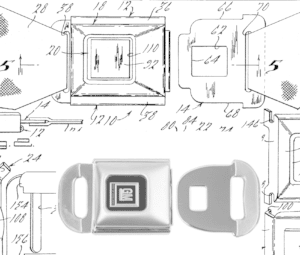A seat belt buckle serves the function of securely joining two ends of the seat belt together, not unlatching during sudden and severe loads, yet be easy for the occupant to unfasten. To understand why GWR’s cantilever buckle is the safest on the roads, it is important to understand the evolution of seat belt buckles.
The first seat belt to be mass-produced in the United States in the 1950’s and 1960’s used a seat belt buckle similar to the ones still used today on commercial airplanes, called a “lift-cover” or “lift-lever” buckle. The seat belt had a male tongue at one end with a hole in it, and would be inserted into the female buckle where a spring-loaded latch pin (pawl) would pass into the hole and hold the tongue in place. The pin would be extracted when the user lifted up the hinged, spring-loaded buckle cover, allowing the tongue to separate from the buckle. This buckle had many weaknesses, the biggest being that the lift-cover could be accidentally dislodged by the occupant’s motions inside the vehicle, leaving the occupant unrestrained in an accident. Below is an image of a lift-lever buckle.
In 1965, Robert Fisher, an employee of General Motors Corporation, designed a buckle which operated similarly to the lift-cover buckle, but used a protected button on the side of the buckle for the lift-cover. This was the first major “side-release” or “top-release” style buckle used in the United States. When the tongue was fully inserted into the buckle, the spring-loaded button would cause the pawl to span into the hole in the tongue. When the occupant wanted to disengage the tongue, they push the button and the pawl would be pushed out of the tongue’s aperture. This buckle was patented in 1965, and called the RCF-65 or “Maxi-Buckle.” Image below.
In 1967, Fisher patented a smaller side-release buckle, which became known as the “RCF-67” side-release buckle, or the Type I buckle in GM vehicles. Image below.
It was a simple buckle design that was easy to manufacture, but it had two principal defects: false latching and accidental unlatching.
First, if the tongue is not inserted completely into the buckle to permit the spring-loaded pawl to fully clip into the aperture, the buckle’s locking mechanism does not come into operation, allowing the tongue to be pulled out of the buckle during a moderate deceleration, significant occupant movement, or the force of the retractor part of the seat belt. This is a “false-latch” or “partial engagement.”
Second, the center push button has the potential to come open or release during impact — inertia acceleration forces on the buckle housing and spring can cause the tongue to release. A force delivered perpendicular to the side release button, can cause the button and linked pawl to become depressed relative to the plane of the tongue, causing the buckle to unlatch inadvertently. A study by the NHTSA showed that out of 225 vehicles tested, 50 would unlatch when the vehicle was subjected to an impact on the back of the buckle. However the NHTSA concluded that even with the lab test, there was not sufficient evidence of inertia unlatching in the real world to warrant action. In 1997, GM simulated a side-impact crash, and the camera captured the seat belt releasing under pressure. The problem with inertial unlatching in side-release buckles has been the subject of intense litigation recently. However, there are limitations the government has to force the automobile industry to issue a recall. Millions of vehicles were never recalled because of the sheer cost of recalling versus fighting a few lawsuits by consumers who realized it was the belt that caused the injury and not the crash.
While seat belt resellers in the United States, and Asian manufacturers, still sell seat belts with copies of this buckle, GWR Safety Systems does not recommend the use of this buckle, or any side or center-release buckle, for on-road or high speed vehicles. All side-release buckle designs have fundamentally the same problems, permitting false and inertial unlatching. All of the automakers have now transitioned into the “European style” end-release buckles that GWR has been manufacturing since it began in 1987 (described below). However, there are still millions of vehicles on the roads today equipped with the side-release buckles, operating at risk of sudden false and inertia unlatching. And because the inherent risk of catastrophic injury is not fully understood by the manufacturers and resellers that continue to sell these buckles for on-highway vehicles, the problem continues.
Despite numerous advances in passive restraint systems over the past two decades, the Federal Motor Vehicle Safety Standards (FMVSS) and industry standards governing the manufacture of seat belts and buckles have essentially remained the same. The government’s watchdog agency, the NHTSA, has done very little to stop the use of the side or center push button release buckles. Therefore, most Americans are largely unaware of false and inertial unlatching until a serious accident occurs. As a result, thousands of Americans who made a conscious effort to wear their seat belts have been killed or seriously injured during auto accidents when their seat belt buckles have become suddenly unlatched.
In the late 1980’s in Europe, the first “end-release” tongue-eject buckles were developed. The end-release buckle has the release button on the end of the buckle (next to the tongue insertion point), instead of on the top or side of the buckle. Locating the release button on the end of the buckle prevents a side-load from accidentally causing the release button to be activated, preventing inertial unlatching. Additionally, the end-release buckle has a tongue-eject feature that prevents false latching.
Seat and vehicle manufacturers must understand the technology behind the seat belt buckles they buy, because designs continue to evolve to improve safety. While end-release seat belt buckles are safer than other buckle designs, end release buckle technology has continued to evolve. Different seat belt manufacturers (and therefore resellers) offer different designs, so it is up to the purchaser to know what they are buying to put in their vehicles. To understand why GWR Safety System’s buckles are the safest available, it is important to look at the technology behind their construction.
GWR uses a cantilever system for our buckles, versus a vertical lever system with springs. The GWR cantilever is a simpler and much better solution for many reasons.

The beauty of the GWR cantilever is that the latch angle reaches around and locks the tongue completely in the event of a crash, but also releases easily because the metal latch doesn’t touch the metal tongue, and is freer to move. Extremely accurate tooling with automotive industry tolerances is required for this buckle.
The GWR cantilever buckle uses less internal components, therefore having less room for error. With less components inside the buckle, they are more spread out, preventing clogging, and making it easier to clean with water. Buckles with more components (especially springs), create more friction and chances that the buckle will not perform as expected when it is needed most. Additionally they can get clogged or become blocked with dust, debris, dirt, and even coca cola over time.
To make the cantilever buckle even more durable, the metal components in the buckle are coated in a high performance corrosion resistant coating, whereas many competing manufacturers use zinc. Our buckles withstand the harsh conditions of wet, cold, and dusty environments for extended periods of time.
GWR has produced millions and millions of our cantilever buckle without ever having a problem.
GWR only sells leading seat belt buckle technology, and uses our original European tooling with automotive industry tolerances. Buckles sold by Asian manufacturers, smaller to mid-size seat belt manufacturers, and resellers of seat belts in the United States, offer outdated designs that are made from copied or inferior tooling, which means the quality is variable.
While some think a seat belt is a seat belt, it is the moment of a vehicle crash where you must be sure you are using seat belts with components that never fail. GWR has been producing our cantilever buckles for three decades, and we have never had a recall, nor a buckle that doesn’t work in a crash. Choose to work with GWR Safety Systems, the seat belt manufacturer that designs and manufactures seat belts for ultimate safety.


